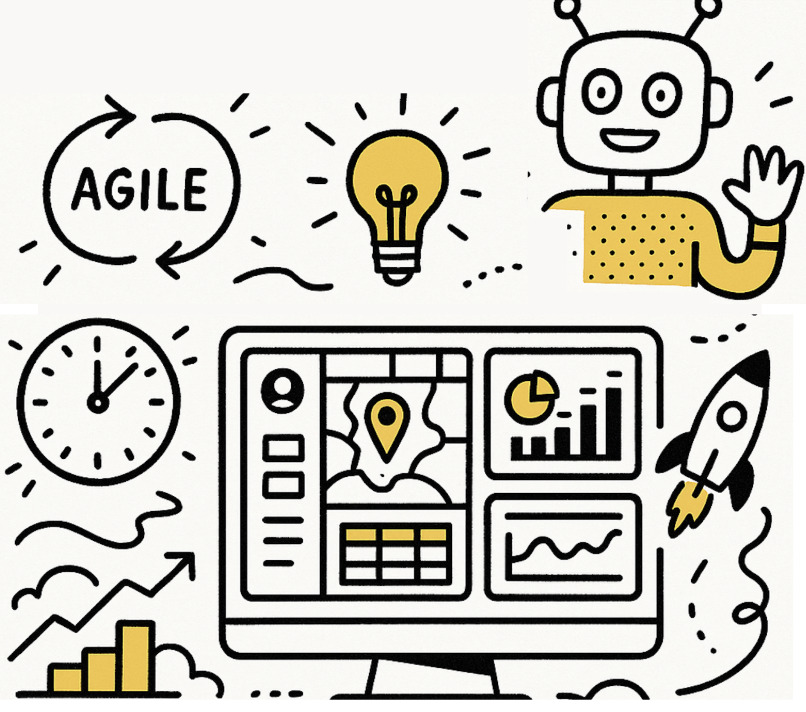
In the world of Agile development, the north star is the feedback loop. The faster we can move from an idea to a working piece of software, the faster we can learn, adapt, and deliver real value. But what happens when the “working software” part involves migrating from a restrictive no-code platform to a fully-coded, custom solution? Traditionally, this means a significant upfront investment in time and resources.
We recently faced this exact challenge. We needed to replace a component built on a no-code tool with a custom-coded analytics dashboard to gain more flexibility and control. In a typical sprint, this kind of project would be a multi-day, if not week-long, endeavour.
Instead, we completed the entire project using AI-powered development tools in a single afternoon. This example illustrates how AI has fundamentally reshaped sprint velocity and the very nature of development work.
The goal: a feature-rich, custom analytics portal
The task was to build a sophisticated and secure analytics module for the existing product suite. It needed to be multi-tenant, meaning each client user could only see their data and the high-level requirements included:
- A secure login system tied to specific customer accounts.
- Detailed data tables and charts showing data across different locations and dates.
- A polished, modern user interface with a specific brand identity.
- An interactive map to visualise locations, with data-driven indicators.
- Filters to allow users to drill down into the data.
The end goal was a high-fidelity component that was not just functional but also provided a seamless and professional user experience, a significant step up from the limitations of the previous solution.
The time-savings: a tale of two sprints
To understand the magnitude of this shift, let’s compare the traditional development path with our new AI-assisted workflow.
Estimated timeline without AI tools: For a senior developer, building this module from scratch would likely take around 40 to 50 hours, or a full developer-week. The breakdown would look something like this:
- Foundation & Setup (1-2 days): Scaffolding the application, configuring the user authentication, and establishing a secure connection to the database.
- UI & Component Library (1-2 days): Building the core UI elements—the navigation, layout, cards, and map wrappers—to match the precise design specifications.
- Business Logic & Integration (1-2 days): Writing the code to fetch, process, and display the data, implementing the filtering logic, and wiring everything together into a cohesive application.
This timeline is standard for creating a robust, production-ready component.
Actual timeline with AI tools: Our AI-powered process transformed this week-long effort into an afternoon sprint.
We began by providing our AI coding assistant via bolt.new with a detailed brief. We described the purpose of the analytics dashboard, the desired UI style, the key features like the map and data tables, and the underlying technical architecture (a modern web framework with a cloud database).
The AI generated a solid foundation for the entire application in seconds. From there, development became a fluid, conversational process using Claude Code. We didn’t just ask it to write code; we asked it to build upon the existing context.
- We requested a new page with a complex data table, and the AI understood which components to reuse and how to structure the new layout.
- We identified a potential performance bottleneck and asked for a caching strategy. The AI provided a practical solution and even ensured its compatibility with our cloud hosting environment.
This iterative collaboration allowed us to focus on refining the product and implementing business logic, rather than getting bogged down in boilerplate code and configuration.
The results
- Total development time: 5h 10m
- Cost of AI tooling: $12.43
- AI models: claude-4-sonnet, claude-3-5-haiku
This represents a 10x reduction in time. The new component was not a rough prototype; it was a deep, well-structured, and polished piece of software. When we presented it, the response was one of enthusiastic approval. The client was thoroughly impressed by both the incredible speed of delivery and the high quality of the final product.
What this means for agile teams
This experience represents a significant change in how Agile teams can operate:
- From migration to innovation instantly: Instead of spending a full sprint just to achieve parity with an old system, we replicated and enhanced it in a few hours. This freed us up to focus immediately on adding new value and features the business had been waiting for.
- Redefining the sprint goal: A sprint goal can now be far more ambitious. What was once an epic can now be a single user story. This allows teams to tackle bigger challenges and deliver more substantial value in each cycle.
- Tighter-than-ever feedback loops: The ability to transition from concept to a fully functional component in hours enables product owners and stakeholders to provide feedback almost in real-time. This dramatically reduces the risk of misinterpretation and ensures the final product is perfectly aligned with the vision.
- Letting developers focus on higher-value tasks: By offloading the tedious and repetitive work, AI tools allow developers to dedicate their full cognitive power to solving meaningful problems. They become architects and refiners, not just coders, leading to better solutions and higher job satisfaction.
We’ve moved into an era where AI is an active collaborator in the development process. For Agile teams, this is a productivity booster, enabling us to build better products faster and more creatively than ever before. The week-long sprint for a single component is a thing of the past; we’re now in the age of the afternoon build.
The Non-Technical Founders survival guide
How to spot, avoid & recover from 7 start-up scuppering traps.
The Non-Technical Founders survival guide: How to spot, avoid & recover from 7 start-up scuppering traps.
